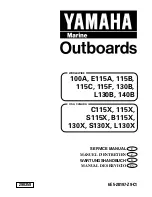
MAINBOARD BIOS SETUP
MAINBOARD BIOS SETUP
P5V30-B4 User’s Manual
P5V30-B4 User’s Manual
22
22
CPU Internal Cache -
Enables or Disables the Level-1 Internal Cache memory. Generally,
this would only be
Disabled
for troubleshooting purposes.
External Cache -
Enables or Disables the Level-2 External Cache memory. Generally, this
would only be
Disabled
for troubleshooting purposes.
Quick Power on Self Test
- Speeds up Power On Self Test (POST) after the computer is
powered on. When set to Enable, the BIOS will shorten or skip some checks during POST.
Hard Disk Boot From
- This option lets you choose to boot from Primary IDE (Pri-IDE),
Secondary IDE (Sec-IDE), or SCSI hard disk. Same as IDE options, the
Boot Sequence
in
the next field is set to
C, A
when the
SCSI
is chosen.
Boot Sequence -
When your system is powered on, the BIOS performs a variety of
operations, then attempts to boot an Operating System from either a hard drive, floppy
drive, or CD-ROM. This setting determines the sequence that the BIOS will follow when
searching devices for a bootable disk. Most users find the
C, A
setting to be most
beneficial, since it takes the least amount of time to boot the system. If however, you want
the ability to boot from a Floppy or CD-ROM drive, you would need to choose either the
A,
C
or
CDROM, C, A
setting. For instance, if your boot sequence was set to
C, A
and for some
reason you wanted to boot to your Floppy A: Drive, it would not be possible, since the BIOS
would always boot from the C: drive first. In this case, this setting would need to be
changed to
A, C
so that the system would first check the floppy drive for a bootable disk.
This would slow bootup speed, however, since the floppy would be checked on every boot.
Swap Floppy Drive
- The hardware connections determine which floppy is configured as
drive A: and drive B: “Swapping” the floppy drives can be useful if your system has two
floppy drives, and you want the ability to boot from both. For example: Since a PC cannot
boot from the B: Floppy, you would need to “Swap” floppy drives A: and B: in order to set
the second floppy drive to drive A:, thereby making it bootable.
Boot Up Floppy Seek
- When enabled, BIOS will determine if the floppy disk drive
installed is 40 or 80 tracks. It will display a warning if the floppy is Low Density (40 Trks).
Floppy Disk Access Control
- When
R/W
, the floppy disk can be read and written. The
other option is
Read Only
.
C, A
System will first search hard disk drive then floppy disk drive for boot sector.
A,C
System will first search for boot sector on floppy disk, then hard disk.
CDROM, C, A
System will first search the CDROM drive, then hard disk drive and then floppy
disk drive for boot sector.
C, CDROM, A
System will first search for boot sector on hard disk drive , then CDROM drive,
and then floppy disk drive.
Enabled
BIOS searches for floppy disk drive to determine if it is 40 or 80 tracks. Note that BIOS
can not tell from 720K, 1.2M or 1.44M drive type as they are all 80 tracks.
Disabled
BIOS will not search for the type of floppy disk drive by track number.
Note that there will not be any warning message if the drive installed is 360K.
















































